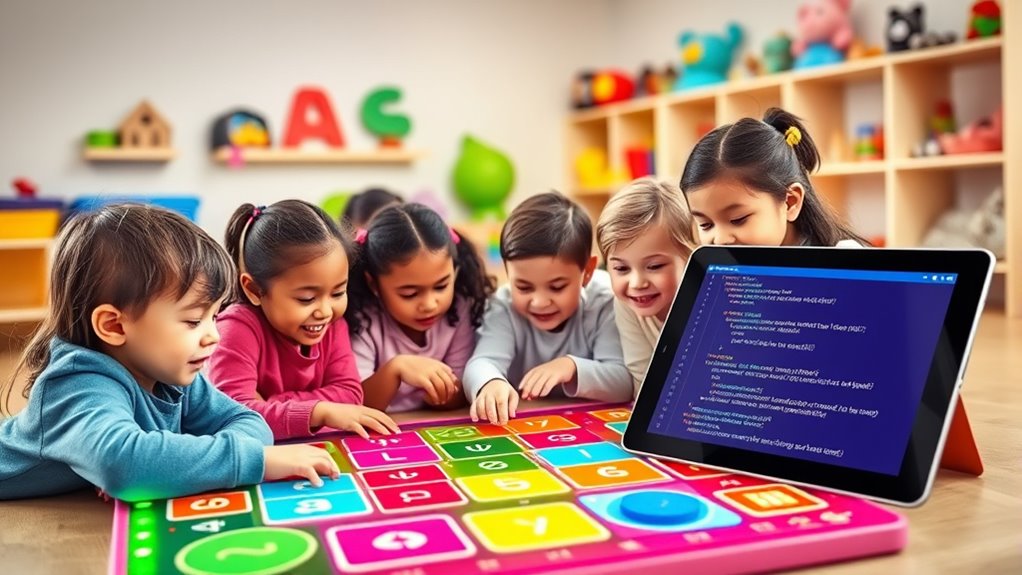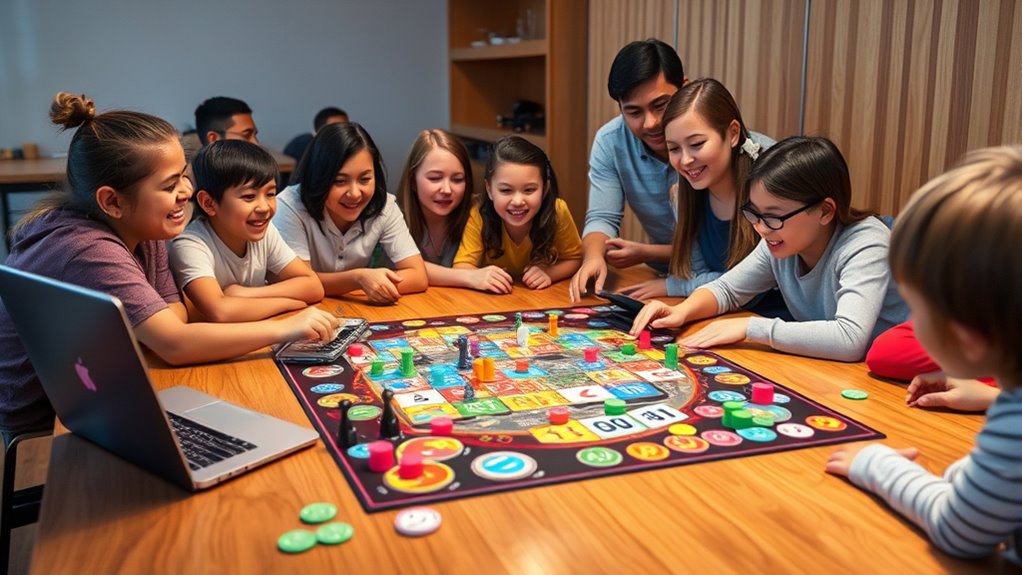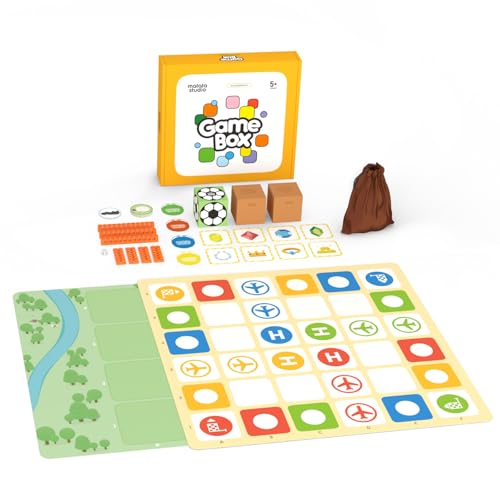I’ve explored many coding board games that turn programming into fun, hands-on experiences for kids. These games teach core concepts like loops, conditionals, and problem-solving through engaging themes like robots, space, and cybersecurity. They’re perfect for home or classroom use and help develop critical thinking skills. If you want to discover the top options that make learning programming exciting and accessible, keep going—there’s plenty more to uncover.
Key Takeaways
- Highlighted games incorporate hands-on components like robots, circuit parts, and tokens to teach coding, algorithms, and problem-solving.
- Many games feature themes such as space, cybersecurity, and math to make programming concepts engaging and accessible.
- They are suitable for a wide age range, often with adjustable difficulty levels and multiple game modes for different skill levels.
- Recognized for promoting critical thinking, logical reasoning, teamwork, and active experimentation in an educational setting.
- Durable materials, expansion options, and curriculum support increase their long-term value and suitability for diverse learning environments.
Makeblock mBot Robot Kit for Kids 8-12
The Makeblock mBot Robot Kit is an excellent choice for kids aged 8-12 who are just starting to explore robotics and programming. I love how easy it is to assemble—most kids can put it together in about 15 minutes with clear instructions. The kit’s sturdy metal parts are durable enough for active play, and it’s compatible with hundreds of modules, allowing for tons of customization. Whether kids want to build obstacle avoiders or line-followers, the mBot supports both simple and advanced coding through intuitive apps. It’s a fantastic way to introduce children to STEM concepts while sparking their creativity and problem-solving skills.
Best For: kids aged 8-12 who are new to robotics and programming, looking for an engaging, educational, and easy-to-assemble kit.
Pros:
- Easy assembly with clear instructions, taking around 15 minutes
- Durable metal parts designed for active play and extensive customization
- Supports both beginner and advanced coding via intuitive apps and software
Cons:
- Limited levels in the learning app may require additional resources for advanced learners
- Occasional software debugging needed, especially for Bluetooth connectivity
- Some users find instructions or component matching slightly challenging during initial setup
STEM Coding Board Game for Learning Computer Programming
Are you looking for an engaging way to introduce computer programming to learners of all ages? I highly recommend the STEM Coding Board Game created by 9-year-old inventor Samaira. This award-winning game has been featured at TIME, NBC, Google, and Maker Faires, reaching over 4,800 children worldwide. It teaches core programming concepts like loops, conditionals, and algorithms through fun, hands-on gameplay. Suitable for ages 4 to 104, it requires no prior experience and is used in schools, libraries, camps, and clubs globally. With accessible curriculum and engaging design, it makes learning computer programming approachable and enjoyable for everyone.
Best For: learners of all ages, from children to adults, seeking an engaging, hands-on introduction to computer programming concepts.
Pros:
- Teaches foundational coding concepts like loops, conditionals, and algorithms through fun gameplay.
- Suitable for a wide age range (4-104) with no prior coding experience required.
- Widely adopted in schools, libraries, and community programs, with accessible free curriculum.
Cons:
- May require adult supervision or guidance for younger children to maximize learning.
- Limited to the scope of programming concepts covered, which may necessitate additional resources for advanced topics.
- As a physical board game, it might be less portable for on-the-go use compared to digital options.
Interactive Learning Toy for Kids with AR Chemistry Kit
Kids who love science and technology will find the AR Chemistry Kit an engaging way to explore chemistry concepts hands-on. This innovative toy uses augmented reality to bring chemical elements, molecular structures, and compounds to life with 4D animations, making complex ideas easier to grasp. It includes 30 flashcards, a periodic table card, and a detailed sheet to help kids master the periodic table through interactive scanning. With multiple learning modes, quizzes, and games, the kit encourages active participation and reinforces understanding. Designed for children aged 10 and up, it makes STEM education fun, accessible, and visually stimulating.
Best For: children aged 10 and above who are passionate about learning science and technology through interactive and engaging methods.
Pros:
- Uses augmented reality with 4D animations to make chemistry concepts visually engaging.
- Includes comprehensive learning materials like flashcards, periodic table card, and detailed sheet for hands-on exploration.
- Features multiple interactive modes, quizzes, and games to reinforce understanding and make learning fun.
Cons:
- May require a compatible device, such as a smartphone or tablet, to access AR features.
- The complexity of some concepts might be challenging for younger children under 10.
- The need for active scanning of multiple cards could be time-consuming for some users.
Game Box with Programming Board Games for Kids 4-10
Designed for children aged 4-10, the Game Box with Programming Board Games offers a fun and interactive way to introduce young learners to coding concepts. This set includes five engaging games—like Treasure Hunt on Grassland and Rescue Sheep—that promote teamwork, logical thinking, and problem-solving through hands-on activities. It’s compatible with the Coding Set and Coding Set Pro STEM Robot, making it perfect for classrooms or family play. The kit contains maps, paper cards, crafts, building blocks, and a user guide for easy setup. With a lightweight design and clear instructions, it makes learning programming accessible and enjoyable for kids.
Best For: educators, parents, and children aged 4-10 seeking a fun, hands-on introduction to coding and STEM concepts through engaging board games.
Pros:
- Promotes teamwork, logical thinking, and problem-solving skills in young learners
- Compatible with popular STEM robots like Coding Set and Coding Set Pro for expanded learning
- Includes comprehensive materials and clear instructions for easy setup and gameplay
Cons:
- Requires AA batteries, which are not included, adding an extra step for setup
- Recommended for ages 8 and up, so younger children may need supervision or assistance
- Limited to specific age range and may require additional guidance for full engagement
STEM Coding Board Game for Learning Computer Programming
The STEM Coding Board Game is an ideal choice for learners of all ages—from young children just starting out to adults exploring programming concepts. Created by 9-year-old inventor Samaira, it’s recognized worldwide, featured at TIME, NBC, Google, and Maker Faires. It teaches core programming ideas like loops, conditionals, functions, and algorithms through fun gameplay with Bunnyz, maze navigation, and code cards. No experience is needed, and the curriculum is free to download. Used in over 600 schools and 380 libraries, it makes coding accessible and engaging for everyone, fostering foundational and advanced skills through hands-on play.
Best For: learners of all ages, from children to adults, seeking an engaging, hands-on introduction to fundamental and advanced programming concepts.
Pros:
- Teaches a wide range of core programming concepts such as loops, conditionals, functions, and algorithms through interactive play.
- No prior coding experience required, with free curriculum available to support diverse learning environments.
- Widely adopted by over 600 schools and 380 libraries worldwide, demonstrating its educational effectiveness and versatility.
Cons:
- May require adult or instructor guidance for younger children to maximize learning outcomes.
- As a physical board game, it may be less suitable for remote or digital-only learning environments.
- Some advanced concepts might need supplementary resources for deeper understanding beyond gameplay.
Think Fun Hacker Cybersecurity Coding STEM Toy for Ages 10
If you’re looking for a challenging and realistic introduction to cybersecurity and programming concepts, Think Fun Hacker is an excellent choice for children aged 10 and up who enjoy puzzle-solving and strategic thinking. With over 50 million units sold worldwide, this game offers 120 escalating challenges that develop reasoning, planning, and logical skills through engaging gameplay. Its components are durable and high-quality, including a game grid, tokens, and challenge booklet. While somewhat complex, especially for younger players, it encourages problem-solving and introduces core programming ideas like concurrency without heavy jargon. Whether played solo or in groups, Hacker makes learning about cybersecurity fun and hands-on.
Best For: children ages 10 and up who enjoy puzzle-solving, strategic thinking, and are interested in cybersecurity and programming concepts.
Pros:
- Engages children with realistic and challenging cybersecurity-themed puzzles that develop critical thinking skills.
- High-quality components and clear instructions make setup and gameplay straightforward.
- Promotes learning of core programming ideas like concurrency in a fun, hands-on way without heavy technical jargon.
Cons:
- Complexity may be overwhelming for younger children or those new to coding, requiring adult guidance.
- Some users report difficulty understanding instructions in English, especially for non-native speakers.
- The game’s size and challenging nature might limit appeal for casual players or those preferring simpler games.
Prime Climb
Looking for a STEM game that truly engages pre-teens and teens? Prime Climb is an excellent choice. It’s a colorful, strategic game suitable for 2-4 players that makes learning math fun. The game helps players master multiplication, division, factorization, and prime numbers through hands-on play. Its simple rules and endless replayability keep players challenged and entertained. Whether for family game night, classroom, or homeschool, Prime Climb fosters critical thinking and deepens math understanding. Plus, the quality is reliable, and customer support is available if needed. It’s a perfect blend of education and entertainment that inspires a love for math.
Best For: families, teachers, and homeschoolers looking for an engaging, educational math game that promotes critical thinking and deepens understanding of prime numbers and related concepts.
Pros:
- Encourages strategic thinking and problem-solving skills through engaging gameplay
- Teaches key mathematical concepts like prime numbers, multiplication, and division in a fun, hands-on way
- Suitable for a wide age range (pre-teens to teens) and versatile for various settings such as family nights, classrooms, or clubs
Cons:
- May require adult supervision or explanation for younger children unfamiliar with math concepts
- The game components might be less appealing to players who prefer more competitive or fast-paced games
- Limited to 2-4 players, which could restrict larger group play or classroom use without multiple sets
Buffalo Games – Tetris
Buffalo Games – Tetris stands out as an excellent choice for families and casual gamers who enjoy strategic, tactile experiences rooted in classic video game themes. I love how it mimics the iconic game with colorful tetrimino pieces and tower-building mechanics. The game encourages strategic placement, line completion, and matching icons for points, making each turn engaging and thoughtful. It’s easy to learn but offers depth for more experienced players. With its durable components and quick setup, it’s perfect for family nights or casual play. Plus, the tactile element and familiar mechanics make it both fun and educational, fostering strategic thinking in a playful way.
Best For: families, casual gamers, and Tetris enthusiasts seeking an engaging, strategic, tactile game experience rooted in the classic video game theme.
Pros:
- Colorful, durable components that mimic the iconic Tetris pieces for visual appeal
- Easy to learn with straightforward setup, suitable for a wide age range
- Promotes strategic thinking and fine motor skills through tactile gameplay
Cons:
- Initial setup can be time-consuming, especially sorting components and assembling towers
- Instructions are only in English, which may pose a challenge for non-English speakers
- No built-in scoring block, making point tracking less convenient
ThinkFun Circuit Maze Game – STEM Toy for Brain-Boosting Circuitry Learning
The ThinkFun Circuit Maze Game stands out as an excellent STEM toy for children aged 8 and up who enjoy challenging, hands-on learning experiences. It combines engaging gameplay with real circuitry components, making complex electrical concepts accessible and fun. Recognized as a Toy of the Year Finalist and a PAL Award winner, it’s highly regarded for quality and educational value. The game boosts critical thinking, logical reasoning, and spatial skills while teaching fundamental circuitry principles. With 60 increasingly difficult challenges, kids can build confidence as they solve puzzles. Compact and easy to start, it’s a perfect gift for curious minds enthusiastic to explore STEM in an interactive way.
Best For: children aged 8 and up who enjoy engaging, hands-on STEM activities that teach circuitry and critical thinking skills.
Pros:
- Develops essential skills like logical reasoning, spatial awareness, and planning.
- Features authentic circuit components and 60 challenging puzzles suitable for various skill levels.
- Recognized for quality and educational value, with positive customer feedback and awards.
Cons:
- Requires 3 AAA batteries (not included), which may be an inconvenience.
- For younger children under age 8, the complexity might be too high without adult assistance.
- The game’s size (11 x 9.5 x 2.5 inches) might be less portable for travel or on-the-go play.
Educational Space and AI Board Game for Kids 6
Are you searching for an engaging way to introduce young children to coding, space, and AI concepts? CoderMarz is a STEM-focused board game designed for kids aged 6 and up, created by 11-year-old inventor Samaira. It teaches Mars facts, AI principles like training and prediction, and coding basics such as loops and conditionals through fun gameplay. With durable components, simple rules, and layered learning, it’s perfect for home, school, or camps. The game’s storyline involves resource collection on Mars, while gameplay introduces kids to real AI training processes. CoderMarz is a mesmerizing tool that makes learning space and programming concepts accessible and exciting.
Best For: parents, teachers, and camp leaders seeking an engaging, educational STEM game to introduce children aged 6 and up to coding, space exploration, and AI concepts in a fun and accessible way.
Pros:
- Combines space exploration with coding and AI education, making complex topics approachable for young learners
- Durable components and simple rules suitable for various settings like home, school, and camps
- Supports layered learning, gradually increasing difficulty to match different skill levels
Cons:
- May require adult guidance for younger children to fully grasp advanced AI concepts
- Limited to gameplay duration of under an hour, which might restrict in-depth exploration in single sessions
- Some children might find the resource collection and strategy elements challenging initially
Educational Board Game for Kids: Teaches AI and Programming
If you’re looking for an engaging way to introduce kids to AI and programming, Coder Mindz stands out as an ideal choice. Created by 9-year-old Samaira and featured by NBC, this game makes complex concepts like neural network training, autonomous systems, and coding fundamentals accessible. It uses fun robots, cards, and tokens to teach skills like loops, conditionals, and data processing through interactive gameplay. Suitable for children 6 and up, it offers adjustable difficulty levels and a free curriculum, making it perfect for home, school, or camps. Coder Mindz fosters early interest in AI, strategic thinking, and problem-solving in an enjoyable, hands-on way.
Best For: parents, teachers, and educators seeking an engaging, age-appropriate way to introduce children aged 6 and above to AI and programming concepts through a fun, hands-on educational game.
Pros:
- Offers an accessible, easy-to-learn gameplay experience suitable for a wide age range and skill levels.
- Comes with a free curriculum that supports classroom, homeschool, and extracurricular learning environments.
- Uses engaging robots, cards, and tokens to promote strategic thinking, problem-solving, and foundational tech skills.
Cons:
- Some users report minor card errors involving programming logic, such as incorrect use of OR instead of AND in loops.
- May require adult supervision or guidance for younger children to fully grasp complex AI concepts.
- As a physical game, it may be less suitable for remote or virtual learning settings without supplementary digital tools.
Pressman The Original Mastermind Game for 2 Players
Looking for a game that sharpens your deductive skills while providing quick, engaging fun? Pressman The Original Mastermind is perfect for two players aged 8 and up. It’s a simple yet strategic game where you create and decode secret color combinations, with over 2,000 possible configurations. This makes each round fresh and challenging. Beyond entertainment, Mastermind promotes critical thinking, logic, and problem-solving—key STEM and STEAM skills. Its straightforward gameplay makes it accessible, while its depth keeps players engaged. Whether for family game night or educational settings, it’s a timeless choice that combines fun with learning.
Best For: enthusiasts of strategic, educational, and engaging two-player games ages 8 and up seeking to develop deductive reasoning and problem-solving skills.
Pros:
- Promotes critical thinking, logic, and STEM/STEAM learning through fun gameplay
- Offers over 2,000 unique color combinations for endless replayability
- Easy to learn with straightforward rules, suitable for players of all skill levels
Cons:
- Limited to two players, so less ideal for larger groups or parties
- May require adult supervision for younger children to understand strategic aspects
- Packaging and design may vary, which could affect presentation for some users
Pressman Mastermind for Kids – Codebreaking Game
Pressman Mastermind for Kids is an engaging codebreaking game perfect for children aged 6 and up who enjoy strategic challenges. It features three levels of play, making it suitable for beginners and more experienced players. Kids take turns setting and solving secret codes, encouraging interactive and critical thinking. The game promotes STEM and STEAM skills, like deductive reasoning, logic, and problem-solving, all while having fun. Bright jungle animal pieces add a playful touch that kids love. Designed for two players, it combines education and entertainment seamlessly, making it an excellent choice for young learners interested in coding, reasoning, and strategic gameplay.
Best For: young children aged 6 and up who enjoy strategic, educational, and playful activities that develop critical thinking and problem-solving skills.
Pros:
- Encourages deductive reasoning, logic, and strategic thinking in a fun, interactive way
- Features three levels of play suitable for beginners and advanced players
- Bright jungle animal pieces add a playful and engaging element for kids
Cons:
- Designed specifically for two players, limiting solo or larger group play options
- May require adult supervision for younger children to understand game rules
- Some children might find the multiple levels of complexity challenging at the very start
Teach Tech Mech 5, Mechanical Coding Robot
The Teach Tech Mech 5, Mechanical Coding Robot is perfect for young learners aged 10 and up who are enthusiastic to explore engineering through hands-on play. It offers a fun, mission-based experience that combines mechanical and coding skills. Kids can make the robot throw, lift, kick, or draw by snapping coding buttons onto its wheel, making programming interactive and engaging. Its modular design allows for easy building and customization, encouraging experimentation. Designed to teach core mechanical principles and coding basics, Mech-5 fosters critical thinking and creativity while making STEM learning accessible and enjoyable for beginners.
Best For: young learners aged 10 and above who are eager to explore engineering and coding through hands-on, interactive play.
Pros:
- Encourages STEM learning through practical building and coding activities
- Modular design allows easy customization and experimentation
- Promotes critical thinking, creativity, and problem-solving skills
Cons:
- May require adult supervision for younger children during assembly
- Limited advanced programming features for more experienced coders
- Design and components may need replacement or upgrades over time with frequent use
Learning Resources Code & Go Robot Mouse Board Game
If you’re searching for an engaging way to introduce young children to coding concepts, the Learning Resources Code & Go Robot Mouse Board Game is an excellent choice. This tactile STEM toy is designed for kids aged 5 and up, focusing on problem-solving, critical thinking, and strategic planning without screens. Players draw coding cards to create sequences that guide their mice through mazes, avoiding barriers and reaching cheese. Its simple setup, durable design, and interactive gameplay make learning fun and accessible. Many parents and educators praise how quickly children grasp coding fundamentals while enjoying the challenge of competing and collaborating in this engaging game.
Best For: young children aged 5-8 who are beginning to explore coding, problem-solving, and critical thinking through hands-on, screen-free gameplay.
Pros:
- Encourages foundational coding skills and strategic thinking without the need for screens or apps.
- Durable, visually appealing design that is easy for young children to set up and understand.
- Promotes collaborative play and critical thinking, making learning engaging and fun.
Cons:
- Limited to early coding concepts; may require additional resources for more advanced learning.
- The physical game may be less portable compared to digital coding tools.
- Some users might find the game’s complexity challenging for very young or less experienced players.
Factors to Consider When Choosing Coding Board Games

When choosing coding board games, I consider factors like age appropriateness and skill level to guarantee the game is engaging without being frustrating. I also look at the educational focus and gameplay complexity to match my goals and players’ abilities. Finally, material durability matters because I want games that will last through regular use and handling.
Age Appropriateness
Choosing the right coding board game depends heavily on age appropriateness, making certain the game matches a child’s developmental stage. I recommend selecting games designed specifically for the child’s age group, such as 4-8 for early learners or 10+ for more advanced players. Check the complexity of rules and challenges to make sure they align with the child’s cognitive abilities. Look for options with adjustable difficulty levels or multiple skill tiers to support growth. Also, consider the physical size and components, making sure they’re safe and manageable for the child’s handling and dexterity. In conclusion, review user ratings and feedback focused on age suitability. This helps confirm the game’s appropriateness, making sure it’s engaging and educational without being too overwhelming or too simple.
Skill Level Match
Matching a coding board game to a child’s skill level guarantees they stay engaged and avoid frustration. I recommend choosing games that align with their age and prior coding experience to promote effective learning. Look for options with adjustable difficulty settings so kids can progress as they develop new skills. It’s important to select games designed for their current understanding—whether they’re beginners or more advanced learners—so the challenges are appropriate and stimulating. Consider whether the game introduces fundamental concepts gradually or expects prior knowledge, ensuring it matches their learning stage. Also, verify that the complexity of rules and tasks suits their developmental level. This tailored approach keeps children confident, motivated, and enthusiastic to continue exploring coding concepts.
Educational Focus
Have you ever wondered what makes a coding board game truly educational? It’s about more than just fun; it’s about teaching core programming concepts like loops, conditionals, functions, and algorithms. When choosing a game, consider whether its focus matches the learner’s age and skill level—whether they’re just learning sequencing or tackling more complex problem-solving. A good game also incorporates STEM principles such as logic, critical thinking, and reasoning, deepening understanding. Look for games that offer a clear curriculum or guided instructions to support skill development and reinforce key lessons. Additionally, tangible components and interactive challenges make abstract concepts more accessible and engaging, helping players connect theory to practice while enjoying the learning process.
Gameplay Complexity
When selecting a coding board game, it’s important to contemplate how complex the gameplay is relative to the players’ age and experience. I look for games with manageable rules and challenges that match the players’ skill levels, ensuring they aren’t overwhelmed. It’s helpful if the game offers adjustable difficulty or multiple levels, allowing progression as abilities grow. I also prioritize games that introduce core programming concepts gradually, like sequences, loops, and conditionals, without confusing beginners. The gameplay should align with the intended learning outcomes, balancing fun with educational value. Clear instructions and visual aids are essential, making complex coding principles easier to understand. Ultimately, the right level of complexity keeps players engaged while fostering meaningful learning.
Material Durability
Choosing a durable coding board game is essential because kids tend to handle games roughly, and frequent use can quickly wear down fragile components. High-quality materials like thick cardboard, reinforced plastic, or solid wood make a significant difference, ensuring the game withstands rough handling. Non-toxic, fade-resistant paints and coatings also help maintain the game’s appearance and safety over time. Well-constructed pieces, such as securely attached tokens and resilient parts, reduce the risk of breakage. A robust design can endure drops, spills, and intense play sessions, extending the game’s lifespan. Additionally, checking product reviews for durability feedback offers valuable insight into how well a game holds up through active use. Prioritizing material durability ensures the game remains functional and engaging for years to come.
Engagement Potential
What makes a coding board game truly engaging for kids? I believe it’s the combination of vibrant components, interactive gameplay, and challenging tasks that keep kids hooked. Hands-on activities, like building or programming with tangible pieces, stimulate the senses and promote active involvement. Games that introduce levels of difficulty or progressive challenges help sustain interest by providing achievable goals and opportunities for mastery. Thematic elements, like space adventures or cybersecurity stories, deepen emotional investment and make the learning experience memorable. Additionally, games that foster social interaction and teamwork encourage children to problem-solve together, making the game more fun and engaging. When these elements come together, kids stay motivated, absorbed, and enthusiastic to learn more about coding.
Expansion Options
Considering expansion options can substantially enhance the longevity and versatility of a coding board game, ensuring it remains engaging as a child’s skills grow. I look for games that offer expansion packs or additional sets, as these can introduce new challenges, themes, and levels that match my child’s evolving interests and abilities. It’s important that expansions are compatible with the base game and integrate smoothly without complicated modifications. I also evaluate their availability and cost to make sure they fit within my budget and are easy to find later. Most importantly, I consider whether these expansions add meaningful educational value, like teaching advanced concepts or encouraging creativity and problem-solving. Well-chosen expansions keep the game fresh, challenging, and educational over time.
Price and Value
When selecting a coding board game, I find it’s essential to weigh its price against the educational value, durability, and replayability it offers. A good game should justify its cost with enough challenges, levels, or components to keep players engaged long-term. I look for games that teach core coding concepts or critical thinking skills aligned with their price point. Comparing prices across retailers helps ensure I get the best deal on a quality product. It’s also wise to contemplate potential additional expenses, like replacement parts or expansion packs, which can add value over time. Ultimately, I focus on whether the game provides meaningful learning opportunities that make the investment worthwhile, balancing cost with educational benefits and durability for sustained enjoyment.
Frequently Asked Questions
Are Coding Board Games Suitable for Beginners?
Yes, coding board games are perfect for beginners. I’ve found they make learning programming concepts much more approachable and fun. These games break down complex ideas into simple, hands-on activities that help you understand logic, algorithms, and problem-solving without feeling overwhelmed. Whether you’re new to coding or just want to practice in a relaxed setting, these games offer an engaging way to build your skills step by step.
How Do These Games Improve Programming Skills?
Coding board games improve my programming skills by making complex concepts easier to grasp through hands-on play. They challenge me to think logically, plan steps ahead, and solve problems creatively. Playing these games helps reinforce coding fundamentals like algorithms and debugging in a fun, engaging way. I find that they boost my confidence and understanding, making me more comfortable with coding in real-world scenarios.
What Age Groups Are Best for Specific Games?
Honestly, these games are like a superhero’s toolkit—perfect for all ages! Younger kids (6-10) thrive with simple logic puzzles, while tweens and teens (11-17) enjoy more complex challenges that boost their coding confidence. Adults? They find these games surprisingly insightful, proving you’re never too old to have fun while sharpening your programming skills. So, pick the game that matches your age, and let the learning adventure begin!
Can These Games Be Used in Classrooms Effectively?
Absolutely, these games work well in classrooms. I’ve seen them spark student interest and promote teamwork while teaching core coding concepts. They’re versatile and can complement lessons or serve as engaging group activities. When I incorporate them, students stay motivated and grasp programming fundamentals more easily. Plus, their tactile nature makes learning fun, helping students develop problem-solving skills in an interactive, memorable way.
Do These Games Require Prior Coding Knowledge?
No, these games don’t require prior coding knowledge. I’ve found they’re designed to introduce programming concepts in a simple, engaging way. Whether you’re a beginner or someone with some experience, these games help you learn through fun challenges and hands-on activities. They’re perfect for building foundational skills without any previous coding background, making them accessible for everyone enthusiastic to learn programming in a relaxed, enjoyable environment.
Conclusion
So, whether you’re just starting out or looking to sharpen your skills, these coding board games are a great way to make learning programming fun. They turn complex concepts into play, proving that practice makes perfect. Don’t put all your eggs in one basket—try a variety to find what clicks best for your kid. Remember, the right game can light a fire of curiosity that lasts a lifetime.


























